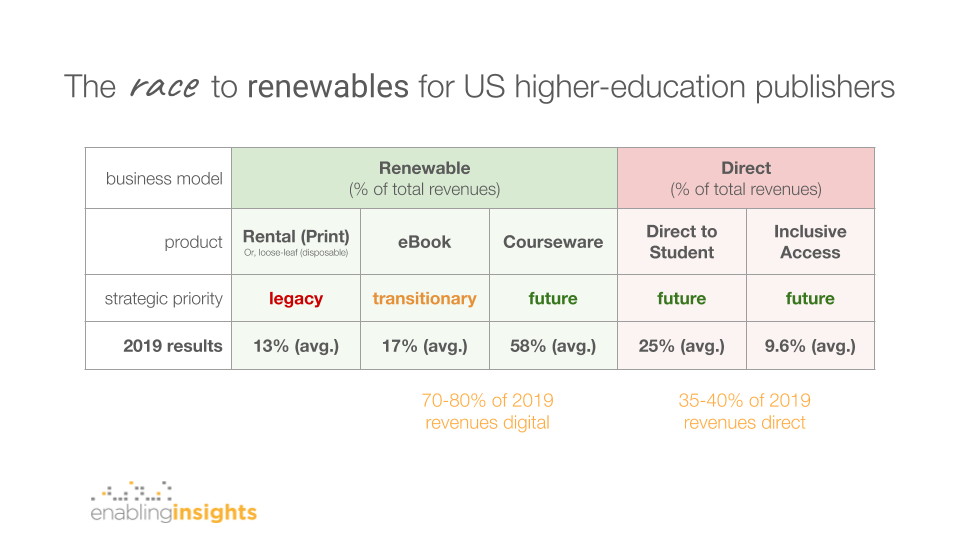The race to renewables: what publishers need to do and why students should win

US higher-education publishers are on a race to renewables and ultimately to become digital subscription businesses. Let’s look at why, how far they’ve got, what they should do next, and why students should ultimately benefit.
Let’s start with the publishers
There have been many industry analyses of what US college students spend (e.g. by the College Board) and what’s behind publishers’ pricing of textbooks (e.g. VOX and Bloomberg). But they miss some critical pieces I’d like to fill in first.
What are the business drivers behind digital subscriptions?
Anyone who’s worked for a US HED publisher knows the recent inside story. Facing declining enrollments, legislation to unbundle, and pressure to reduce prices (e.g. the goals of The Affordable College Textbook Act), publishers have struggled. But, they’ve continued to invest huge sums in elaborate and comprehensive support packages necessary to win and service competitive adoptions. They have carried high risk (few “titles” are revised or become best sellers, and many eye-wateringly large investments in tech have failed—some are humorously ranked here). They’ve priced for a one-year return (before revenues dry up and shift to the used-book market, and to hit gross margins rooted in a print era). And, they’ve carried the financial burden and inefficiencies of managing two fundamentally different businesses (print and digital). But, moving to digital subscription products enables these companies to (once again) realize a sale with every student, every year, for a major course adoption. This could reverse their fortunes.
How are education publishers trying to get there: a race to renewables?
The US higher-education market is fragmented and moving at different speeds. Some customers (many instructors and some students, perhaps through necessity) still want print. So, the big US publishers have developed complicated (and internally inefficient) portfolios comprising multiple offerings for today’s fragmented market while strategically trying to nudge their customers to a range of “renewable” or “consumable” products as stepping stones to digital subscription services.
How far have they got?
Each publisher reports results differently, so it’s hard to see that they’re pursuing essentially the same strategies—a race to renewables with one sale per student—or how far they’ve got. To try to help, I’ve deconstructed 2019 results for the top three US higher-education publishers from their public investor reports and mapped these to a common framework (the underlying analysis is by publisher, but I’ve shown only averaged results to avoid a bun fight!). Some figures are approximate since they are derived from publishers providing differing (e.g. how to count a digital sale or subscription), often hyped, and sometimes overtly opaque reporting. But, to within a couple percent, in 2019, the top three US higher-education publishers achieved 70–80% of their revenues as digital, and 35–40% as direct to student (from their own ecommerce and Inclusive Access).

Are they out of the woods?
Putting aside COVID-19 (which hasn’t had the catastrophic impact on US higher-ed 2020 sales that was initially expected), I’d said no. The problem is that they’re still running two businesses—a legacy print business, and an aggressive and dynamic digital business—and each with fairly independent workflows, tools, talent, investments, business models, and margins (no matter how unified they may say these are). This is complex, costly, and inefficient. And, evolving to a consumer-focused, digital-first subscription business is held back by legacy org design and thinking. The bravest decision they could make would be to shut down print overnight, take the hit on sales, and resize and reconfigure entirely to become a digital education subscription business. (The big three are taking steps towards this, but somewhat organically—rather than backwards-reengineering their organization to be a subscription business.)
Finally, let’s turn to the customer—the student
So, why should students ultimately benefit? Many may see publishers’ progress to digital as yet another way to exploit students. But, I think there are good reasons to be optimistic that the consumer can and should win:
- Better results: not all digital courseware was created equal, but there is an undeniable body of evidence (here’s just one example) to suggest that well-designed courseware drives substantially higher student engagement, (in-course) retention, and other outcomes—and tantalizing evidence that some courseware delivers better learning equity too.
- Evergreen content: with used-books in their rear-view mirror, publishers can move beyond the contrivance of three-year revisions and instead focus on evergreen content appropriate to the subject and type of subscription offering.
- Greater convenience: students want flexibility in how and when they study, and digital subscription products they can snack on with their mobiles and study hard online with their laptops and tablets provide a lot of convenience and utility.
- Always-improving experiences: with direct, dynamic insights and feedback from students for online subscription services, publishers have the ability to understand their end consumers like never before and evolve their products and services to better serve their needs.
- Value-driven prices: and now for the punchline. If (and that’s a big if) publishers aggressively retire print and resize and reorganize themselves around digital subscriptions, their costs and business models should settle out to pass on better, value-driven prices to students. And, with more affordable products accessible to more students on the first day of class, more will succeed.
A call to action for publishers
So, my call to action for publishers: be brave, reorganize to digital subscriptions, and price for your end customer and the value you give them. You won’t satisfy all of the market, but trying to serve everyone means you risk pleasing almost no-one and preventing your business from evolving to a more sustainable future.
Need help?
If you want a fast and incisive assessment of your current strategy and practical tips for how to sharpen and evolve it for faster progress and greater likelihood of success, we’d love to help. Please contact us today with the form provided below.
